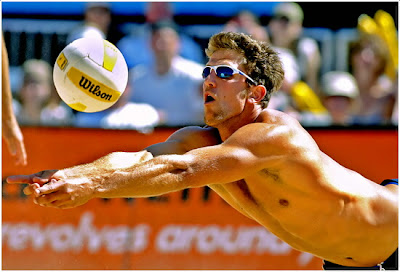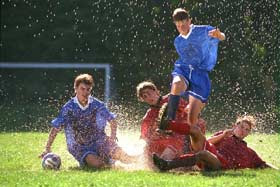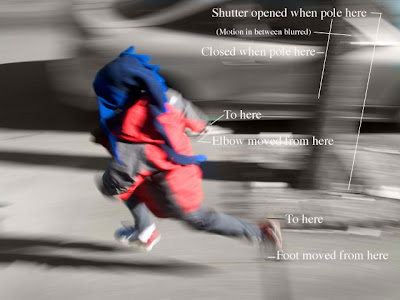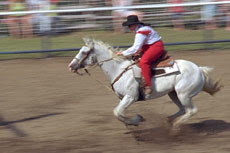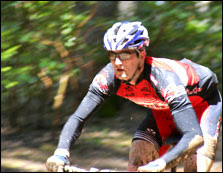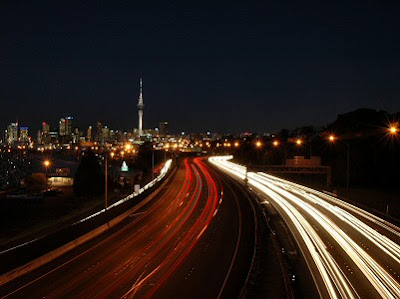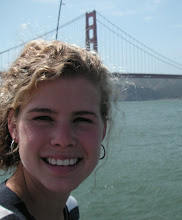This is the final of the print of Rozy jumping off of the cement block. I tried various other combinations, putting three separate images together with photoshop. I decided to use these two, as Rozy was perfectly in focus in these two shots, and I also like the poses and how active they look. The two shots that I started with were these two:

 I took the first one and used it as the background in a photoshop canvas. I then copied Rozy from the second image and placed her as a layer on top of the background. then I erased the areas around Rozy in the second image so that she was superimposed on top of the first.
I took the first one and used it as the background in a photoshop canvas. I then copied Rozy from the second image and placed her as a layer on top of the background. then I erased the areas around Rozy in the second image so that she was superimposed on top of the first.Then I took a piece of the blue wavy wall and fixed the size and angle and everything and added it to the lefthand side of the print in order to extend the wall.
This is the final print:

The final print is alright. I think that a landing would have been good, because it seems more logical to have three poses in a jump like this. On the other hand, I like the way that it is incomplete without a landing, and kind of fun that she is in the air in both poses. I also like the way the second pose looks like she is floating down onto the ground. Tried to apply a cool filter to the clouds, but this didn't improve them much, perhaps I should have tried more things to make the sky more dynamic and less bland.
Print Two: Rozy Cannonballing
This one was the one that I tried before doing the one above. It helped me to learn how to work with the different layers in photoshop, adding a new layer and erasing the extra stuff around Rozy to make it look like the poses are in the same frame.
I began with these three shots:
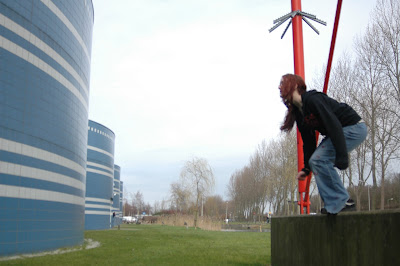
 This one I chose because I like the cannonball and the way her hair flies and it looks like she is just on the verge of jumping out of the frame of the photo.
This one I chose because I like the cannonball and the way her hair flies and it looks like she is just on the verge of jumping out of the frame of the photo.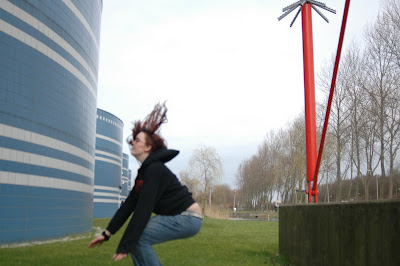
Final Print:
 The final print is alright. As I mentioned in my diary entry, the print is very symetrical, and she is moving completely to horizontal with respect to the camera, so there isn't very much creative or new to this one. I do like the poses themselves individually, and also the way that she is in focus enough to see her poses, but not enough to really see her face or anything. Also, the launch of this one is really nice, because you can see her motion of literally pushing off of the cement block to lift into the air. Much more effort shown in this one than print one.
The final print is alright. As I mentioned in my diary entry, the print is very symetrical, and she is moving completely to horizontal with respect to the camera, so there isn't very much creative or new to this one. I do like the poses themselves individually, and also the way that she is in focus enough to see her poses, but not enough to really see her face or anything. Also, the launch of this one is really nice, because you can see her motion of literally pushing off of the cement block to lift into the air. Much more effort shown in this one than print one.Extra Print: Lauren in Flight
 I included this extra print just because I took it while in the middle of editing the one of Rozy at a track meet over the weekend, and think it follows with the whole idea of shooting motion. Besides not being sharp enough, the motion itself is good, as Lauren is caught mid-air, completely stretched out at the top of her jump. Also, I crouched pretty low down close to the track and shot at a slightly upwards angle to make her look more elevated.
I included this extra print just because I took it while in the middle of editing the one of Rozy at a track meet over the weekend, and think it follows with the whole idea of shooting motion. Besides not being sharp enough, the motion itself is good, as Lauren is caught mid-air, completely stretched out at the top of her jump. Also, I crouched pretty low down close to the track and shot at a slightly upwards angle to make her look more elevated. 
